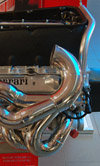No room to manoeuvre
 The modern racing engine, benefiting from many hours of dyno development time and a great deal of simulation, should at least have a well-optimised exhaust system in terms of length. When compared to a Formula One car, sports cars have a lot of room in which to lay the exhaust system out without requiring extremely tight bends.
The modern racing engine, benefiting from many hours of dyno development time and a great deal of simulation, should at least have a well-optimised exhaust system in terms of length. When compared to a Formula One car, sports cars have a lot of room in which to lay the exhaust system out without requiring extremely tight bends.
In Formula One however, there are much tighter constraints on the exhaust, particularly in view of the dominant position of aero in the overall design of the car. After all of the other necessary components are in place, namely the radiators and coolers, there is little space left in which to cram the exhaust system. This is the reason why we see the beautifully crafted but tortuously curved systems on the ‘spy-shot’ photographs we see on engines at the track. (It is quite common to equip show engines with dummy parts, including exhausts, in order to mislead the competition and, having been in the fortunate position of working on more than one manufacturer Formula One engine programme, I have seen that this is indeed the case).
The Formula One exhaust system is incrementally forced into smaller and smaller spaces each year, with pressure on the exhaust manufacturers to make the systems ever lighter and more durable. Leaving materials choices aside for the moment, we will look at the traditional manufacturing methods used for a typical racing exhaust system. In general the exhaust ‘stubs’ which are used to mount the exhaust system to the engine will be investment cast or, in some circumstances, fabricated by hand using a mixture of tube, sheet and machined components. The casting route is more precise and allows the exact form of the transition from the shape formed by the port at the cylinder head exit to the diameter of the first round section to be managed precisely. This ensures that the area schedule decided by 1D simulation can be adhered to closely.
Once the cast transition has reached the round section to which the main primary pipes are welded, we are then into the realm of the fabricator’s artwork. Each time I look at a set of primaries I have to admit to being very impressed, and this is true of those systems still made by the teams themselves, as well as those made by the few excellent external suppliers that supply the Formula One teams. Until relatively recently, the remainder of the exhaust system was made of a collection of bent tubes both in Formula One and other formulae. However, as space restrictions have become tighter, particularly in Formula One, the fabrication methods have become more specialised. Individual bends are sometimes made as pressed parts to allow a much tighter bend radius than can be achieved by tube-bending equipment. The process involves pressing individual halves of bends from flat sheet and welding them together to form a tight radius. It is possible in this way to form a centre-line bend radius which can be as low as 70 percent of the tube diameter, i.e. a 42.5 mm bend radius on a 60 mm diameter tube. I certainly wouldn’t suggest that such tight bends are commonly used, but they are possible. It is common for an Formula One exhaust to have one or more steps in the exhaust and these are formed either by fabrication or by having sections cast. The size of this step and its severity change from team to team, but they seem to be universal at the moment.
In general, the collector will be fabricated from a mixture of tube and sheet, with various degrees of internal complication. The collector is generally made complete with the tailpipe, and these can be of various designs ranging from a simple tube to a section which changes constantly to form an elliptical exit.
In future articles we shall examine some of the other design features, more modern manufacturing methods including those not yet in widespread use in Formula One and materials choices.
Written by Wayne Ward.